Iasi - Picture
More about World War 1
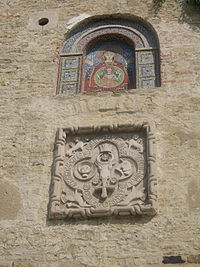
|
|
Iasi
Iasi
Iasi (also historically referred to as Jassy or Iassy) is the second most populous city (according to the last census) and a municipality in Romania. Located in the historical Moldavia region, Iasi has traditionally been one of the leading centres of Romanian social, cultural, academic and artistic life. The city was the capital of the Principality of Moldavia from 1564 to 1859, then of the United Principalities from 1859 to 1862 and the capital of Romania from 1916 to 1918.
Known as The Cultural Capital of Romania, Iasi is a symbol in Romanian history. The historian Nicolae Iorga said "There should be no Romanian who does not know of it".
Still referred to as The Moldavian Capital, Iasi is the seat of Iasi County and the main economic centre of the Romanian region of Moldavia. Home to the first Romanian university and to the first engineering school, it is the second largest university centre in the country and accommodates over 75,000 students in 5 public and 7 private universities. The social and cultural life revolves around the Vasile Alecsandri National Theater (the oldest in Romania), the Moldova State Philharmonic, the Opera House, the TÄtÄrasi Athenaeum, a famous Botanical Garden (the oldest and largest in Romania), the Central University Library (the oldest in Romania), the high quality cultural centres and festivals, an array of museums, memorial houses, religious and historical monuments.
Etymology and names
The city is historically referred to as:
German, Polish, English: Jassy
French: Iassy
Hungarian: Jx¡szvx¡sx¡r
Russian: Yassy
Yiddish: Yas
Greek: Ix sio
Turkish: Yas
Ukrainian: Yasy
Italian: Jassi
Scholars have different theories on the origin of the name "Iasi". Some argue that the name originates with the Sarmatian tribe Iazyges (of Iranian origin), one mentioned by Ovid as "Ipse vides onerata ferox ut ducata Iasyx/ Per media Istri plaustra bubulcus aquas" and "Iazyges et Colchi Metereaque turba Getaque/ Danubii mediis vix prohibentur aquis".
A now lost inscription on a Roman milestone found near Osijek, Croatia by Matija Petar KatanÄiÄ in the 18th century, mentions the existence of a Jassiorum municipium, or Municipium Dacorum-Iassiorum from other sources.
Another explanation is that the name originated from the Iranian Alanic tribe of Jassi. The Hungarian name of the city (Jx¡szvx¡sx¡r) literally means "Jassic Market"; the antiquated Romanian name, Tx¢rgul Iesilor (and the once-favoured Iasii), may indicate the same meaning.
Oral sources say that the name may come from an archaic form of the Romanian word "to exit" because the city was an important trade node in the region.
History

Picture - Coat of arms of the Principality of Moldavia at CetÄÅ£uia Monastery
Ancient times
Archaeological investigations attest the presence of human communities on the present territory of the city and around it as far back as the prehistoric age. Later settlements included those of the Cucuteni-Trypillian culture, a late Neolithic archaeological culture.
Early development
The name of the city is first officially mentioned in a document about commercial privilege granted by the Moldavian Prince (Voivode) Alexandru cel Bun to the Polish merchants of Lvov in 1408. However, as buildings older than 1408 existed and still exist (for example the Armenian Church originally believed to be built in 1395), it is believed that the city existed long before its first mentioning.
Capital of Moldavia
Around 1564, Prince Alexandru LÄpusneanu moved the Moldavian capital from Suceava to Iasi. Between 1561 and 1563, a school and a Lutheran church were founded by the Greek adventurer Prince, Ioan Iacob Heraclid.
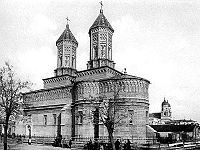
Picture - Three Hierarchs Monastery
In 1640, Vasile Lupu established the first school in which the mother-tongue replaced Greek, and set up a printing press in the Byzantine Trei Ierarhi Church (Church of the Three Hierarchs; built 1635-39). In 1643, the first volume ever printed in Moldavia was issued in Iasi.
Picture - The Princely Court of Moldavia, early 19th century
The city was burned down by the Tatars in 1513, by the Ottomans in 1538, by the Imperial Russian troops in 1686. In 1734, it was hit by the plague.
Through the Peace of Iasi, the sixth Russo-Turkish War was brought to a close in 1792. A Greek revolutionary maneuver and occupation under Alexander Ypsilanti (ÎλÎξανδÏÎ¿Ï Î¥ÏηλάνÏηÏ) and the Filiki Eteria (Φιλική ÎÏαιÏία) (1821, at the beginning of the Greek War of Independence) led to the storming of the city by the Turks in 1822. In 1844 there was a severe conflagration.
Mid-19th to 20th century
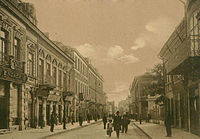
Picture - Al. LÄpusneanu Street
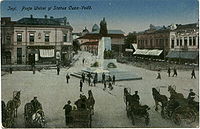
Picture - Union Square
Between 1564 and 1859, the city was the capital of Moldavia; then, between 1859 and 1862, both Iasi and Bucharest were de-facto capitals of the United Principalities of Moldavia and Wallachia. In 1862, when the union of the two principalities was recognized under the name of Romania, the national capital was established in Bucharest. For the loss caused to the city in 1861 by the removal of the seat of government to Bucharest the constituent assembly voted 148,150 lei to be paid in ten annual instalments, but no payment was ever made.
During World War I, Iasi was the capital of a severely reduced Romania for two years, following the Central Powers' occupation of Bucharest on 6 December 1916. The capital was returned to Bucharest after the defeat of Imperial Germany and its allies in November 1918. In November-December 1918 Iasi hosted the Jassy Conference.
Jewish community
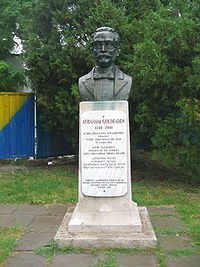
Picture - Avram Goldfaden's statue near the Iasi National Theatre
Iasi also figures prominently in Jewish history. Records of Jews exist from the 16th century, and by mid-19th century, owing to widespread Russian Jewish and Galician Jewish immigration into Moldavia, the city was at least one-third Jewish. In 1855, it was the home of the first-ever Yiddish-language newspaper, Korot Haitim, and, in 1876, the site of what was arguably the first-ever professional Yiddish theater performance (see Avraham Goldfaden).
The words of HaTikvah, the national anthem of Israel, were written in Iasi by Naphtali Herz Imber.
According to the 1930 census, with a population of 34,662 (some 34%) out of the total of 102,872, Jews were the second largest ethnic group in Iasi. There were over 127 synagogues.
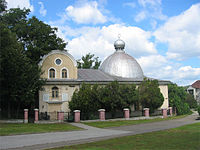
Picture - The Great Synagogue, built in 1671
After World War II, Iasi played a prominent part in the revival of Yiddish culture in Romania, from 1949 to 1964, it was home to a second company of the State Jewish Theater.
Today, Iasi has a dwindling Jewish population of ca. 300 to 600 members and two working synagogues, one of which, the 1671 Great Synagogue, is the oldest surviving synagogue in Romania. There is also a Jewish community center serving kosher meals from a small cantina.
Outside of the city on top of a hill there is a large Jewish Cemetery which has graves dating from the late 19th century; burial records date from 1915 to the present day and are kept in the community center.
World War II
During the war, while the full scale of the Holocaust remained generally unknown to the Allied Powers, the Iasi pogrom stood as one of the known examples of Axis brutality toward the Jews.
The pogrom lasted from 29 June to 6 July 1941, and over 13,266 people, or one third of the Jewish population, was massacred in the pogrom itself or in its aftermath, and many were deported. The pogrom began as a diversionary tactic. Due to its proximity to the Soviet border, the city's Jewish population was accused of aiding the Bolsheviks, and rumors were promoted among the general population that the Jews were anti-Romanian. The pretext for the pogrom included a minor Soviet air attack on the city on 26 June 1941, two days after Romanian and German forces attacked the Soviet Union.
After a second air attack two days later, the 14th Infantry Division, led by General Stavrescu declared its mission of eradicating "those who are aiding the enemy". In a telegram, Stavrescu wrote that the Russian aviators "had accomplices among the Judeo-communist suspects of Iasi." Under express orders from military dictator and German ally Ion Antonescu, the city was to be "cleansed" of its Jewish population. Orders also specified that Section Two of the General Headquarters of the Romanian Army and the Special Intelligence Service (SIS) of Romania were to spread rumors of Jewish treachery in the press, including ones that Jews were guiding Soviet military aircraft by placing lights in their houses' chimneys.
A systematic massacre by the Iasi police, Romanian and German soldiers, and a portion of the citizens of Iasi followed and at least 8,000 Jews were killed; more than 5,000 Jews were loaded onto overcrowded, sealed "death trains" that drove slowly back and forth across the country in the hot summer weather until most of their passengers were killed by hyperthermia, thirst, or infection and bleeding.
Six Romanians of Iasi are credited with saving around one hundred Jews (see Righteous Among the Nations).
In May 1944, Iasi became the scene of ferocious fighting between Romanian-German forces and the advancing Soviet Red Army and the city was partially destroyed. The elite German Panzergrenadier Division Groxdeutschland won an impressive defensive victory at the Battle of Tx¢rgul Frumos, a location near Iasi. The battle was the object of several NATO studies during the Cold War. By July, Iasi had been taken by Soviet forces.
Geography
Topography
Picture - The Copou hill
Located in the North-East of Romania, between the Iasi Ridge (Romanian: Coasta Iasilor) (the northern-most hill formation of the Bx¢rlad Plateau) and the Jijia Plain, Iasi used to be the crossroads place of the commercial routes that passed through Moldavia coming from Kingdom of Poland, Habsburg Monarchy, Tsardom of Russia and Constantinople.
The city lies on the Bahlui River, a tributary of the Jijia (tributary of the Prut). The surrounding country is one of uplands and woods, featuring the monasteries of Bx¢rnova, Bucium, CetÄÅ£uia, Frumoasa, Galata (with nearby Nicolina mineral springs), Hlincea, and the dendrologic park of Repedea. Iasi itself stands amid vineyards and gardens, partly on hills, partly in the in-between valley.
It is a common belief that Iasi is built on seven hills (coline in Romanian): CetÄÅ£uia, Galata, Copou-Aurora, Bucium-PÄun, Åorogari, Repedea and Breazu, thus triggering comparisons with Rome.
Climate
Iasi has a humid, continental-type climate (Kx¶ppen climate classification "Dfb" - summer wetter than winter, European subtype) with four distinct seasons. Summers are warm with temperatures sometimes exceeding 32 °C (90 °F) while winters are cold and windy with moderate snowfall and temperatures at night sometimes dropping below â10 °C (14 °F). Average monthly precipitation ranges from about 25 mm (1 in) in October to 100 mm (4 in) in June.
Cityscape
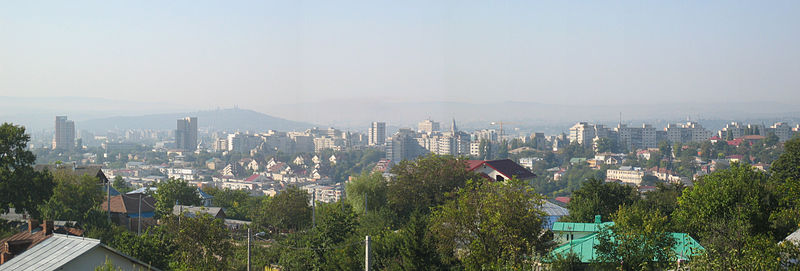
Picture - Panoramic view over Iasi
Architecture
Picture - Grand Hotel Traian (1882), designed and built by Gustave Eiffel
Picture - Hotel Select
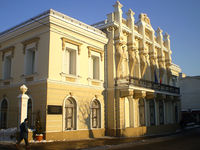
Picture - Cuza Palace, The Union Museum
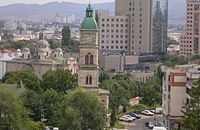
Picture - BÄrboi Church as seen from the Golia Tower
With historical monuments, 500-year-old churches and monasteries, contemporary architecture, many of them listed on the National Register of Historic Monuments, Iasi is an outstanding educational center, and preserves some beautiful pieces of architecture, such as the Trei Ierarhi Monastery, included on the tentative list of UNESCO World Heritage Site, or the neo-Gothic Palace of Culture, built on the old ruins of the mediaeval Princely Court of Moldavia. During World War II and the Communist regime some historical buildings in the old city center (around Union Square area) were destroyed or demolished, and replaced by International style buildings and also a new mainly Mid-Century modern style Civic Centre was built around the Old Market Square (The Central Market).
Other notable buildings:
Alexandru Ioan Cuza University main building, 1897, a mixture of the Neoclassical and Baroque styles, houses the famous Hall of the Lost Footsteps where one can admire the works of the painter Sabin BÄlasa;
"Vasile Alecsandri" National Theatre, built between 1894 and 1896 in Neoclassic style with Baroque and Rococo inspired painted and sculpted ornaments;
Metropolitan Cathedral, the largest Orthodox church in Romania, a late Renaissance style, with Baroque elements and Gheorghe Tattarescu paintings;
Dosoftei House, a building from the second half of the 17th century in which in 1679, the metropolitan bishop Dosoftei settled the second typography in Moldavia. With three facades, arched and right-angled windows, the edifice was restored between 1966 and 1969. It houses the department of old literature of the Romanian Literature Museum;
Golia Monastery, 1564, rebuilt in 1650 in late-Renaissance style with Byzantine frescoes and intricately carved doorways, is a monumental construction, a monastery in the middle of the city, surrounded by tall walls, with corner turrets, and a 30 m (98.43 ft) height bell tower;
Roznovanu Palace (The City Hall), second half of the 18th century, rebuilt between 1830 and 1833, during World War I, it hosted the Romanian government;
Union Museum, beginning of the 19th century, Empire style, the palace served as the royal residence of Prince Al.I. Cuza between 1859 and 1862 and in 1917-1918, during World War I, as the royal residence of king Ferdinand;
Great Synagogue, built in 1657-1671, is the oldest surviving synagogue in Romania and one of the oldest in Europe;
Pogor House, 1850, a meeting place for the city intellectuals, the headquarters of Literary Society Junimea (1863) and of the Convorbiri literare (Literary Interlocutions) magazine (1867), houses the Romanian Literature Museum;
Armenian Church, built in 1395, testifies the existence of an important Armenian community in these parts of Romania;
LuceafÄrul Theater, 1987, a unique modern building in Romania;
Old Catholic Cathedral, 1782, in Baroque style, and New Catholic Cathedral, 2005;
Central University Library, 1934, incorporates Greek Revival elements;
Iasi Central Rail Station, 1870, inspired by Venetian Doge's Palace.
Monasteries and churches
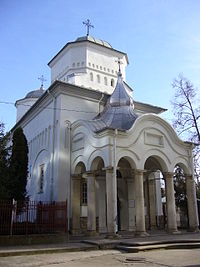
Picture - Barnovschi Church
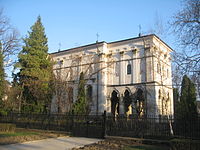
Picture - St. George Church (Old Metropolitan Cathedral)
Iasi is the seat of the Romanian Orthodox Metropolitan of Moldavia and Bukovina, and of the Roman Catholic Bishop of Iasi. There are currently almost 10,000 Roman Catholics living in Iasi. There is a debate between historians as to whether the Catholics are originally of Romanian or Hungarian descent.
The city and area house more than 10 monasteries and 100 historical churches. One of the oldest is Royal Saint Nicholas (1491), dating from the reign of Stephen the Great and the largest in Romania is the Metropolitan Cathedral; perhaps the finest, however, is the 17th century old metropolitan church, Trei Ierarhi, an example of Byzantine art, erected in 1635-1639 by Vasile Lupu, and adorned with countless gilded carvings on its outer walls and twin towers. Other examples of beautiful churches and monasteries, some surrounded by big walls, are: Socola (1562), Galata (1582), Saint Sava (1583), Hlincea (1587), Aroneanu (1594), Bx¢rnova (1603), Barnovschi (1627), Golia (1650), CetÄÅ£uia (1668), Frumoasa (1726), Saint Spiridon (1747), Old Metropolitan Cathedral (1761), BÄrboi (1843 with 18th century bell tower), Bucium (1853).
Gardens and parks
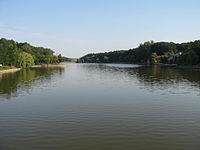
Picture - Ciric Park
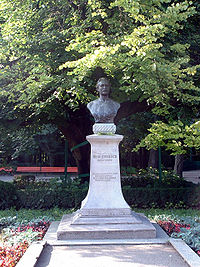
Picture - Mihai Eminescu's statue and his Linden Tree in Copou Park
Iasi has a diverse array of public spaces, from city squares to public parks.
Begun in 1833, at the time when Iasi was the capital of Moldavia, by Prince Mihail Sturdza and under the plans of Gheorghe Asachi and Mihail Singurov, Copou Park was integrated into the city and marks one of the first Romanian coordinated public parks. The oldest monument in Romania stands in the middle of the park, the Obelisk of Lions (1834), a 13.5 m (44.29 ft) tall obelisk, dedicated to the Law of Organic Rules, the first law on political, administrative and juridical organization in Romanian Principalities.
Founded in 1856, the Botanical Garden of Iasi, the first botanical garden in Romania, has an area of over 100 hectares, and more than 10,000 species of plants.
Iasi Exhibition Park was opened in 1923 and built under the coordination of the architect N. Ghica Budesti.
The Ciric Park, located in the north-eastern part of Iasi is another complex which consists into the park and four lakes.
Cultural life
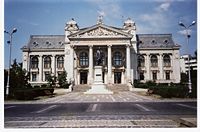
Picture - Vasile Alecsandri National Theatre
Major events in the political and cultural history of Moldavia are connected with the name of the city of Iasi. The great scholars of the 17th century Grigore Ureche, Miron Costin and later Ion Neculce, wrote most of their works in the city or not far from it and the famous scholar Dimitrie Cantemir known throughout all Europe also linked his name to the capital of Moldavia.
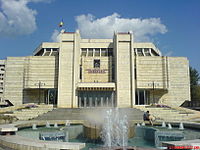
Picture - LuceafÄrul Theatre
The first newspaper in Romanian language was published in 1829 in Iasi and it is in Iasi where, in 1867, appeared under literary society Junimea, the Convorbiri literare review in which Ion CreangÄâs Childhood Memories and the best poems by Mihai Eminescu were published. The reviews Contemporanul and ViaÅ£a Romx¢neascÄ appeared in 1871, respectively in 1906 with great contributions to promoting Romanian national cultural values.
Many great personalities of Romanian culture are connected to Iasi: the chronicler Nicolae Milescu, the historians and politics men Mihail KogÄlniceanu or Simion BÄrnuÅ£iu, the poets Vasile Alecsandri or George Topx¢rceanu, the writers Mihail Sadoveanu, Alecu Russo, or Ionel Teodoreanu, the literary critic Titu Maiorescu, the historian A.D. Xenopol, the philosophers Vasile Conta or Petre Andrei, the sociologist Dimitrie Gusti, the geographer Emil RacoviÅ£Ä, the painter Octav BÄncilÄ, only to name a few.
Theatres and orchestras
Picture - Moldova State Philharmonic
The "Vasile Alecsandri" National Theatre, opened in 1840, is the oldest National Theatre in Romania. The building, designed according to the plans of the Viennese architects Hermann Helmer and Ferdinand Fellner, was raised between 1894 and 1896, and also hosts, starting 1956, the Iasi Romanian National Opera.
Iasi is also home to:
"Moldova" State Philharmonic Orchestra
"LuceafÄrul" Theater for children and youth
TÄtÄrasi Athenaeum
Museums
Picture - Pogor House, The Romanian Literature Museum
Iasi is home to many museums, memorial houses, art galleries. First Memorial House from Romania opened in Iasi in 1918 as Ion CreangÄ Memorial House, and today the Iasi Romanian Literature Museum owns twelve memorial houses. The Mihai Eminescu Museum is situated in Copou Park and it is dedicated to the great poetâs life and creation. Other museums are dedicated to: Dosoftei, Mihail KogÄlniceanu, Vasile Pogor, Nicolae Gane, Petru Poni, Mihai Codreanu, Mihail Sadoveanu, George Topx®rceanu, Otilia Cazimir, Radu CernÄtescu.
The Theatre Museum, opened in 1976, at the celebration of 160 years since the first theatrical performance in Romanian, illustrates the development of the theatrical phenomenon since the beginning, important moments of the history of Iasi National Theatre, the foundation, in 1840, of the Philharmonic-dramatic Conservatoire, prestigious figures that have contributed to the development of the Romanian theatre.
The Union Museum, includes original pieces and documents which belonged to prince Al. I. Cuza and his family.
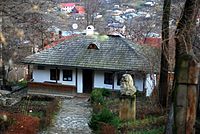
Picture - Ion CreangÄ Memorial House
The Natural History Museum, founded on 4 February 1834, is the first museum of this kind in Romania with over 300,000 items, the most valuable being the collections of insects, mollusk, amphibians, reptiles, birds, plants and minerals.
Four other museums are located in the Palace of Culture, The Art Museum has the largest art collection in Romania, with more than 8,000 paintings, out of which 1,000 belong to the national and universal patrimony, The Moldavia's History Museum, offers more than 35,000 objects from various fields, archaeology, numismatics, decorative art, ancient books, documents, The Ethnographic Museum of Moldavia owns more than 11,000 objects depicting the Romanian advance through the ages and The Science and Technology Museum with five distinct sections and one memorial house.
Foreign culture centres
Picture - French Cultural Center
Iasi hosts five cultural centres: French, German, British, Latin American & Caribbean and Hellenic.
Periferic Biennial
Periferic is an international biennial of contemporary art organized in Iasi, Romania by the Vector Association. Eight editions have taken place thus far.
Media
Economy
Iasi is an important economic centre in Romania. The local and regional economy relies on public sector institutions and establishments.
The most important sectors are related to health care, education, research, culture, government, tourism and manufacturing. It is active in automotive, pharmaceutical industry, metallurgical production, textiles and clothing, constructions, banking, wine, preserved meat.
The city is an important IT sector centre, with software companies and two universities that provide high quality graduate engineers.
Iasi is also a well-developed commercial city with many shopping malls and commercial centres.
Largest employers
Sources:
Demographics
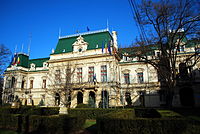
Picture - Roznovanu Palace, today Iasi City Hall
According to the last Romanian census, from 2002, there were 109,357 housing units and 320,888 people living within the city of Iasi, making it the second most populous city in Romania. Additionally there are 60,000 more residents (mostly students) and thousands of daily commuters.
Of this population, 98.5% are ethnic Romanians, while 0.59% are ethnic Roma, 0.13% Jews, 0.13% Greeks, 0.13% Lipovans, 0.08% Hungarians, 0.05% Germans and 0.39% others.
In terms of religion, 92.5% of the population are Christian Orthodox, 4.9% Roman Catholic, other religious groups 2.6%.
As of 2009, 315,649 inhabitants live within the city limits, a decrease from the figure recorded at the 2002 census.
Iasi Metropolitan Area has a combined estimated population of 400,347, an area of 808 km² and includes the municipality of Iasi and 13 other nearby communities.
Education
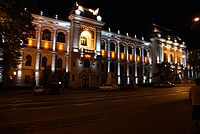
Picture - Al. I. Cuza University building at night
The first institute of higher learning that functioned on the territory of Romania was Academia VasilianÄ (1640) founded by Prince Vasile Lupu as a "higher school for Latin and Slavonic languages", followed by the Princely Academy in 1707.
The first high education structure in Romanian language was established in the autumn of 1813, when engineer Gheorghe Asachi laid the foundations of a class of engineers, its activities taking place within the Greek Princely Academy.
After 1813, other moments marked the development of higher education in Romanian language, regarding both humanities and the technical science. In 1835, Academia MihÄileanÄ founded by Prince Mihail Sturdza is considered first Romanian superior institute in the country.
Picture - University of Medicine and Pharmacy and the Union Monument
In 1860, three faculties part of the Academia MihÄileanÄ formed the nucleus for the newly-established University of Iasi, the first Romanian university.
The Physicians and Naturalists Society, founded in Iasi, has existed since the early part of the 19th century, and a number of periodicals are published. One of the oldest medical universities in Romania, founded in 1879, is in Iasi. It is now known as the Grigore T. Popa University of Medicine and Pharmacy.
In 1937, the two applied science sections of the University of Iasi became departments of the newly created Gheorghe Asachi Polytechnic School. In the period before and after World War II, the later (renamed Polytechnic Institute in 1948) extended its domain of activity, especially in the field of engineering, and became adopted a Technical University in 1993.
Public Universities:
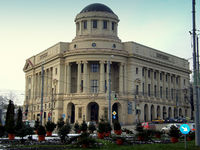
Picture - Central University Library
Alexandru Ioan Cuza University
Gheorghe Asachi Technical University
Grigore T. Popa University of Medicine and Pharmacy
George Enescu University of Arts
Ion Ionescu de la Brad University of Agricultural Sciences and Veterinary Medicine
Besides the universities, there are schools of art and music.
The Central University Library of Iasi, where the chief records of Romanian history are preserved, is the oldest and the second largest in Romania.
Health
Iasi is home to at least 15 hospitals, including the St. Spiridon Hospital, the second largest and one of the oldest in Romania, St. Maria Clinic Children's Hospital, Socola Psychiatric University Hospital and Institute of Cardiovascular Diseases.
Transportation
Rail
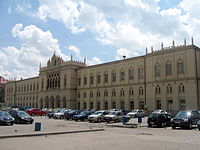
Picture - Central Railroad Station (built in 1870)
Iasi-Pascani railway was opened on 1 June [O.S. 20 May] 1870, Iasi-Ungheni on 1 August 1874 and Iasi-ChisinÄu railway was opened on 1 June 1875 by the Russian Empire in preparation for the Russo-Turkish War (1877-1878).
Nowadays, three train stations, Central Rail Station, Nicolina International Rail Station and Socola Rail Station serve the city and are operated by Romanian Railways (CFR). Moldovan railway also serves these stations for travel into Moldova.
The Iasi Central Rail Station, located about 1 km to the city centre, provides direct rail connections to all the major Romanian cities and to ChisinÄu. The rail stations are very well connected to all the parts of the city by the trams, and buses of the local public transport company, RATP.
Air
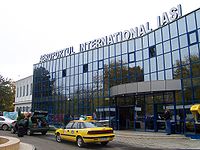
Picture - Iasi Airport Terminal
Iasi is served by the Iasi International Airport (IAS) located 8 km east of the city centre. The airport has nonstop flights to and from Bucharest, Timisoara, Rome and Vienna.
Road
Iasi is connected to European routes E58/E583/E85 with Bucharest through a four lane express road. It is also planned an East-West freeway connection to Romanian Motorway A3 (also known as "Transylvania Motorway").
The Iasi Coach Station is used by several private transport companies to provide coach connections from Iasi to a large number of locations from all over the country.
Public transport
Two operators, the local public transport company, RATP Iasi, and Unistil, a private company, provide public transit within the Iasi city and operate an extensive network using 150 trams (electric trams began operating in Iasi in 1900) and 150 buses. In the first 3 months of 2007, RATP carried 11,365,819 passengers, an average of 128,000 passengers per day.
Monuments and history
International relations
Twin towns - Sister cities
Iasi is twinned with:
ChisinÄu, Moldova (2008)
Assiut, Egypt (1995)
Athens, United States (2001)
Filacciano, Italy (1999)
Forano, Italy (1999)
Irbid, Jordan (2000)
Isfahan, Iran (1999)
Jericho, Palestinian Authority (2003)
Kozani, Greece (1928)
Monterrey, Mexico (2002)
Morlupo, Italy (1999)
Nazzano, Italy (1999)
Padua, Italy (1995)
Peristeri, Greece (2002)
Poitiers, France (1969)
Quebec City, Canada (2001)
Sant'Oreste, Italy (1999)
Torrita Tiberina, Italy (1999)
Villeneuve d'Ascq, France (2003)
Vinnytsia, Ukraine (1993)
Xi'an, China (1993)
Veliko Turnovo, Bulgaria (1998)
Consulates in Iasi
Moldova - Consulate-General
Honorary Consulates:
Hungary
Italy (Vice Consulate)
Pakistan
People
See: List of people from Iasi
Bibliography
This article incorporates text from a publication now in the public domain: Chisholm, Hugh, ed (1911). Encyclopx¦dia Britannica (Eleventh ed.). Cambridge University Press.
National Institute of Statistics: http://www.insse.ro
More aircraft.
Source: WikiPedia